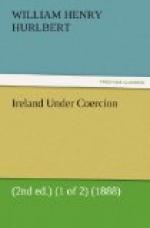At Burtonport we found the “Gombeen man,” of Dungloe, represented by a very large “store.” He runs steamers between this place and various ports on the Scottish and Irish coasts, bringing in goods and taking out the crops which his debtors turn over to him.
This Burtonport “store” towers high above the modest home of the parish priest, Father Walker. To our great regret he was absent on parochial duty, but his niece very kindly welcomed us into his modest study, where we left a note begging him to honour us with his company at dinner in Dungloe.
Mr. Hammond, too, was absent, so after paying our respects to his wife, we drove back to Dungloe, and walked about the village till dark, chatting with the good-natured, civil people. The local sensation here they tell us is not the trial of the priests at Dunfanaghy, but a “row” breeding between the chief of the Sweeneys and one of his brethren over the possession of Her Majesty’s Post-office. It seems there is an official regulation or custom that the post-office once established in a particular building shall not be moved thence without positive cause shown. The head of the Sweeneys, having completed his new and grand establishment, wishes to move the post-office thither; but the brother to whom he confided the office in the older building, where he left it while making the change of his own business, now desires to keep the office where it is, and, I suppose, to become postmaster himself![17] A trivial matter enough, but not without edification for students of the actual situation in this most curious country.
About seven o’clock Father Walker made his appearance—a fine-looking, dignified, most amiable man. He is a teetotaller, which we esteemed a stroke of good fortune, a bottle of port wine which we obtained, despite the “boycott,” from the Gombeen shop, proving to be of such a quality that it might have been concocted in the last century, expressly to discredit the Methuen treaty.
Father Walker is the President of the National League branch.
Like Father M’Fadden at Gweedore, he speaks of the landlords in this part of Donegal as really owning, not so much farms as residential grounds for tenants who export their thews and sinews to Scotland and other countries, and live by that traffic mainly. It is a common practice here, he tells me, for the children, who are very sharp and bright, to be taken by their parents into Tyrone and other parts of the North, and put out to live with the people there, who prize them, and pay very good wages. I asked him if he thought the official estimate I had seen of the proportion of these “migratory labourers” to the whole population of Ulster, as about one-tenth of one per cent., an under-statement. He thought it was an under-statement for this part of the county of Donegal, but to be explained, perhaps, by the fact that so much of the migration is merely from one county into another, and not out of the kingdom. He agreed that the practice goes on upon a much more extensive scale in the County Mayo, where more than thirteen per cent, of all the adult male population are said to belong to the category of migratory labourers. The Irish population of England seems to be recruited at regular seasons in this way, very much as is the Albanian population of Constantinople.




